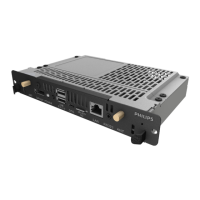
Do you have a question about the Philips CRD50 and is the answer not in the manual?
Essential safety guidelines for operation, maintenance, and handling of the OPS Module.
Declarations of conformity with EU directives and US FCC regulations.
Notices from Polish testing centers and information on Electromagnetic Fields (EMF).
Ventilation advice for Nordic countries and hazardous substance information for China.
Compliance with hazardous substance rules and e-waste disposal across various regions.
Information regarding the manufacturer, location, and EAC certification.
Steps for opening the package and checking contents.
Lists the items included in the CRD50 package.
Important considerations and notes for installing the OPS module.
Step-by-step instructions for physically mounting the CRD50 into a display.
Identification and description of all external ports on the CRD50 device.
How to select video inputs and adjust picture display settings.
Navigating the user interface and accessing administrative functions.
Detailed explanation of the Admin Mode menu, including Settings, Apps, Network, and Storage.
Configuring core settings, Wi-Fi connectivity, and wired network setup.
Steps for automatic network setup using DHCP.
Manual network setup using static IP addresses.
Setting the device name and personalizing the boot animation.
Managing custom boot animation files for personalized startup sequences.
Enabling and configuring the device's screenshot feature.
Configuring screenshot intervals, repeat cycles, and save locations.
Purging old screenshots and setting up email alerts for system events.
Setting up the SMTP server for sending email notifications.
Configuring email for notifications and FTP for file transfer.
Setting FTP port and managing media sources like Media Player and Browser.
Configuring server, account, and version for CMND & Play features.
Configuring PDF playback and installing/managing custom applications.
Setting startup applications and configuring proxy servers.
Using system tools for factory resets, storage clearing, and import/export.
Cloning media files and managing external storage devices.
Configuring remote support and updating the device software.
Adjusting text size and viewing device storage details.
Configuring security options and selecting the system language.
Setting device date, time, time zone, and enabling developer features.
Accessing device information and performing software updates.
Viewing open-source licenses and accessing quick device status information.
Detailed guide on creating and applying custom boot animations.
Methods for installing apps via File Manager, ADB, or custom intents.
Process for installing custom boot animation files.
How to interface with the device's local web server for data retrieval.
List of video codecs and file formats compatible with USB playback.
List of image formats and codecs compatible with USB playback.
Procedures for safely cleaning the exterior of the OPS module.
Details on connectivity, power requirements, dimensions, and weight.
Operational and storage limits for temperature, humidity, and altitude.